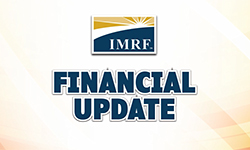As the sponsor of a defined benefit pension, your employer bears the risks of the IMRF investment portfolio. When IMRF fails to earn its assumed rate of return of 7.25%, like in 2022, the difference is drawn from IMRF Employer Reserve accounts. As a result, the average IMRF employer saw a (48.5)% decrease in its Employer Reserve account. But why was this average decrease so substantial if IMRF only lost (12.8)% in 2022? To explain, it's important to first understand that the 2022 market loss does not correlate directly to the residual impact on employer reserves.
The residual amount is the difference between how much IMRF’s investments actually earned and the 7.25% interest granted on the opening balances of reserve accounts plus 0.5% for operating costs.
The reported market investment rate of return does not consider the 7.25% IMRF expected to make for the year. In good years, the residual percent will always be less than the investment return and in bad years, the residual percent will be more negative. See the percentages for the last four years below. As shown, they vary.
| 2022 | 2021 | 2020 | 2019 | |
|---|---|---|---|---|
| Investment Return | (12.8)% | 16.6% | 14.8% | 19.6% |
| Residual Percent | (23.0)% | 11.6% | 8.6% | 14.5% |
The residual calculation takes into account the annuitant reserve and the employer reserve. When you add these amounts together, the result is (23)% for all employers.
The easiest way to calculate the percentage is to take the residual distribution amount, and divide by the total of the Employer and Annuitant Reserve amounts from the 2021 GRS vs IMRF Recon Adjustments Schedule in the Annual Documents section in Employer Access. This calculates to (23.0)%. If there were annuitants receiving a Voluntary Additional annuity and/or have returned to work, those amounts would need to be subtracted from the annuitant reserve total.
Calculations
The calculation for all IMRF employers is:
| Employer | Annuitant | Total | % of Opening Balance |
|---|---|---|---|
| 20,469,641,863.92 | 29,173,126,705.24 | 49,642,768,569.16 | |
| Estimated Residual Loss Used | (11,410,378,884.00) | (23.0)% | |
To simplify the approximate calculation of the residual loss amount, multiply the total of the member, employer, and annuitant reserves (above) by 7.25%, which is the interest granted on each. This is the amount IMRF expected to make. So IMRF is down $(4.16) billion. Add the approximate investment loss for the year $(7.41) billion for a total loss of $(11.57) billion. This is close to the residual amount estimated above $(11.41) billion that was distributed to all employers.
| Member | Employer | Annuitant | Total Reserves |
|---|---|---|---|
| 7,723,735,649.07 | 20,469,641,863.92 | 29,173,126,705.24 | 57,366,504,218.23 |
| Interest Granted | 7.25% | ||
| Expected to Make | 4,159,071,555.82 | ||
| Estimated Loss | (7,414,455,979.00) | ||
| Difference from Expected/Residual Loss | (11,573,527,534.82) | ||
Example
Here is an example for a typical IMRF employer:
| Employer Reserve | Annuitant Reserve | Total | |
|---|---|---|---|
| Opening balance - a | 38,578,136 | 59,769,107 | 98,347,243 |
| Ending balance - b | 16,982,857 | 64,311,832 | 81,294,689 |
| Residual - c | (22,617,384) | (22,617,384) |
|
| Residual as a percent of opening balance: c/a | (58.6)% | (23.0)% | |
| Decrease in reserve(s): (c-a)/a | (56.0)% | (17.3)% |
Additional information or questions
View a video update from IMRF Executive Director Brian Collins on IMRF's 2022 investment return, funded status, and overall financial position.
If you have additional questions about this topic, please contact IMRF at 1-800-728-7971 (employers only) or send a secure message in Employer Access.


